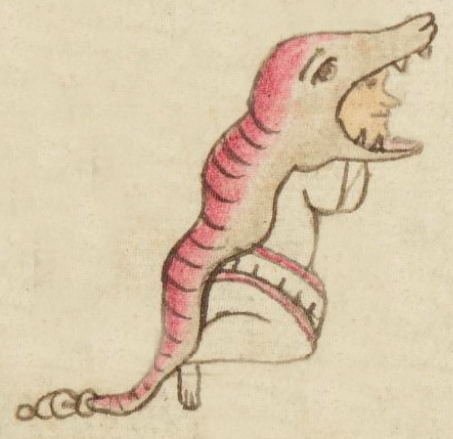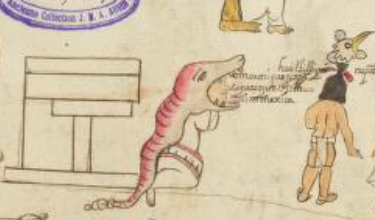Cihuacoatl (Azca17)
This painted black-line drawing of the compound glyph for a deity name or high political title, Cihuacoatl, shows a nearly vertical, undulating serpent (coatl) with its mouth open. Out of the mouth peers a face. The body seemingly associated with this face is that of a woman, with her knees bent and her legs tucked under her. She wears traditional clothing, including a pink or red border on either a skirt or a blouse. The serpent has a rattler tail. Its belly is natural and its back is a dark pink, with short lines running counter to the length of the body. The visible eye of the serpent is open, and sharp teeth are visible in its mouth.
Stephanie Wood
The gloss suggests that the Cihuacoatl–likely intending here the title of a political elite male–of Colhuacan witnessed the death of some Mexica (perhaps Huitzilihuitl and his daughters). Having a temple next to the Cihuacoatl underlines the likelihood that he was a man with the high title.
Stephanie Wood
omca mique ixpā ciguacoguatl colhuacan in mexica
oncan mique ixpan Cihuacoatl Colhuacan in Mexica
Stephanie Wood
post-1550, possibly from the early seventeenth century.
Jeff Haskett-Wood
muerte, muertos, títulos políticos, fuerzas divinas femeninas, serpientes, nombres de mujeres, crótalos, ondulante

Cihuacoatl, female divine force of the Earth, also a title for the second highest political office in the Tenochcan Mexica political structure after the tlatoani, https://nahuatl.wired-humanities.org/content/Cihuacoatl
(un título de un élite político)
Stephanie Wood
The Codex Azcatitlan is also known as the Histoire mexicaine, [Manuscrit] Mexicain 59–64. It is housed in the Bibliothèque Nationale de France, and hosted on line by the World Digital Library and the Library of Congress, which is “unaware of any copyright or other restrictions in the World Digital Library Collection.”
https://www.loc.gov/resource/gdcwdl.wdl_15280/?sp=17&st=image
The Library of Congress is “unaware of any copyright or other restrictions in the World Digital Library Collection.” But please cite Bibliothèque Nationale de France and this Visual Lexicon of Aztec Hieroglyphs.




